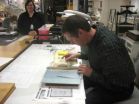(Press-News.org) The Massachusetts General Hospital (MGH) research team that first discovered tumor-associated RNA in tiny membrane-enclosed sacs released into the bloodstream by cancer cells has now found that these microvesicles also contain segments of tumor DNA, including retrotransposons – also called "jumping genes" – that copy and insert themselves into other areas of the genome. The investigators' report, which has been published in Nature Communications, is the first to show that microvesicles are involved in transferring retrotransposons between cells.
"Retrotransposons' action of self-copying and reinserting themselves into the genome leads to genetic instability," says Johan Skog, PhD, who led the current study while an investigator in the MGH Neurology Service. "Many researchers have proposed this as a mechanism for genetic diversity and for evolution. Retrotransposons are known to be upregulated in cancer, and discovering them in microvesicles that can be found in all body fluids suggests they could be useful biomarkers to help understand tumor progression and monitor treatment response."
Skog was lead author of a 2008 study that first identified tumor-associated RNA in microvesicles, also called exosomes, released by the deadly adult brain tumor glioblastoma. To further investigate the ability of microvesicles to reflect the genetic status of tumors, in the current study the MGH team analyzed the nucleic acid contents of microvesicles from glioblastomas, from two types of pediatric brain tumors, and from malignant melanomas.
They found that the microvesicles contained tumor DNA as well as RNA and that microvesicles from one of the pediatric tumors studied had elevated levels of both DNA and RNA from the oncogene c-Myc, which correlated with the gene's expression in that tumor. "We showed that amplification of c-Myc was present in microvesicles whenever it was present in the donor cell and that microvesicle analysis can reveal oncogene expression in the original tumor," explains Leonora Balaj of MGH Neurology, the first author of the study.
High levels of retrotransposon-associated RNA sequences were also detected in tumor microvesicles, and the investigators found those microvesicles could transfer their contents into normal cells. "One of the most important functions of tumor-derived microvesicles may be modification of normal cells in the microenvironment to make them more supportive of tumor growth," says study co-author Xandra Breakefield, PhD, MGH Neurology and a professor of Neurology at Harvard Medical School.
###Skog is now the director of research for Exosome Diagnostics, the company that licensed the work described in the 2008 paper, and continues to consult with Breakefield's research team. Additional co-authors of the Nature Communications report are Ryan Lessard, MGH Neurology; Lixin Dai, Johns Hopkins School of Medicine; and Yoon-Jae Cho, MD, and Scott Pomeroy, MD, PhD, Children's Hospital Boston. The study was supported by grants from the National Cancer Institute, the Wenner-Gren Foundation, and Stiftelsen Olle Engkvist Byggmastare.
Celebrating the 200th anniversary of its founding in 1811, Massachusetts General Hospital is the original and largest teaching hospital of Harvard Medical School. The MGH conducts the largest hospital-based research program in the United States, with an annual research budget of nearly $700 million and major research centers in AIDS, cardiovascular research, cancer, computational and integrative biology, cutaneous biology, human genetics, medical imaging, neurodegenerative disorders, regenerative medicine, systems biology, transplantation biology and photomedicine. END
Tumor microvesicles reveal detailed genetic information
Presence of 'jumping genes,' amplified oncogenes may be key to tumor progression
2011-02-14
ELSE PRESS RELEASES FROM THIS DATE:
UTHealth, Athersys preclinical research on stem cell therapy for stroke presented at AHA conference
2011-02-14
HOUSTON and LOS ANGELES – February 10th, 2011 – Medical researchers from The University of Texas Health Science Center at Houston (UTHealth) presented new research results at the American Heart Association International Stroke Conference that demonstrated how MultiStem®, a novel stem cell therapy being developed by Athersys, Inc. provided multiple benefits when administered in preclinical models of ischemic stroke. The study, conducted by leading researchers from the Department of Neurology at the UTHealth Medical School working in collaboration with scientists at Athersys, ...
Restructuring natural resource majors
2011-02-14
Madison, WI FEBRUARY 3, 2011 – A troublesome trend is occurring at colleges and universities around the country: fewer students are graduating with degrees in natural resource related degree programs. As a result, the number of qualified professionals to manage fish and wildlife programs is dwindling. What is even more troubling is that nationally, the percentage of students enrolling in the major has increased. For reasons unknown, students have been leaving the natural resource degree path after enrollment to pursue other degrees. Finding cause for the steady decline ...
Study related to diet soda and stroke risk is seriously flawed
2011-02-14
Contact: Stan Samples
ssamples@kellencompany.com
404-252-3663
Calorie Control Council
Study related to diet soda and stroke risk is seriously flawed
Study is drawing a growing body of criticism and skepticism from experts in the field of nutrition and science
The Calorie Control Council stated today that research findings presented during a poster session at the International Stroke Conference claiming an association between diet soft drink consumption and increased risk of stroke and heart attack are critically flawed.
"The findings are so speculative and preliminary ...
Sandia security experts help Kazakhstan safely transport, store Soviet-era bomb materials
2011-02-14
ALBUQUERQUE, N.M. — A Sandia National Laboratories team helped reach a major milestone in the nation's nuclear nonproliferation efforts by working with the Central Asian country of Kazakhstan to move nuclear materials — enough to build an estimated 775 nuclear weapons — to safety.
Sandia provided security and logistics expertise to complete the transfer across Kazakhstan of spent fuel containing 11 tons (10 metric tons) of highly enriched uranium and 3.3 tons (3 metric tons) of weapons-grade plutonium that had been stored in a BN-350 fast-breeder reactor in the busy Caspian ...
Wayne State study: Enhance romance by going out with other couples
2011-02-14
DETROIT— Romantic relationships often start out as enjoyable or even exciting, but sometimes may become routine and boring. A Wayne State University study reveals that dating couples that integrate other couples into their social lives are more likely to have happy and satisfying romantic relationships.
Richard B. Slatcher, Ph.D., assistant professor of psychology in WSU's College of Liberal Arts and Sciences and a resident of Birmingham, Mich., specializes in social and health psychology. His recent research suggests that spending quality time with other couples may ...
VCU Massey first to combine targeted agents to kill multiple myeloma cells
2011-02-14
Richmond, Va. (Feb. 10, 2011) – Scientists at Virginia Commonwealth University Massey Cancer Center have developed a novel treatment strategy for multiple myeloma that pairs two targeted agents to kill cancer cells. The study's findings, published in today's edition of the journal "Blood," are the first to demonstrate the synergistic, anti-myeloma effects of this combination regimen both in vitro and in vivo.
Multiple myeloma is a cancer involving antibody-producing cells in the bone marrow, and, in most cases, is incurable. Targeted therapies work by interfering with ...
University of Arizona experts determine age of book 'nobody can read'
2011-02-14
University of Arizona researchers have cracked one of the puzzles surrounding what has been called "the world's most mysterious manuscript" – the Voynich manuscript, a book filled with drawings and writings nobody has been able to make sense of to this day.
Using radiocarbon dating, a team led by Greg Hodgins in the UA's department of physics has found the manuscript's parchment pages date back to the early 15th century, making the book a century older than scholars had previously thought.
This tome makes the "DaVinci Code" look downright lackluster: Rows of text ...
Powerful new ways to electronically mine research may lead to scientific breakthroughs
2011-02-14
The Internet has become not only a tool for disseminating knowledge through scientific publications, but it also has the potential to shape scientific research through expanding the field of metaknowledge—the study of knowledge itself.
The new possibilities for metaknowledge include developing a better understanding of science's social context and the biases that can affect research findings and choices of research topics, according to an article published by University of Chicago researchers in the journal Science. Pooling research-related information online can shed ...
Roses get celery gene to help fight disease
2011-02-14
A rose by any other name would smell … like celery?
North Carolina State University research intended to extend the "vase life" of roses inserts a gene from celery inside rose plants to help fight off botrytis, or petal blight, one of the rose's major post-harvest diseases.
Some fungal pathogens, the bad guys that infect plants, produce a sugar alcohol called mannitol that interferes with the plant's ability to block disease like petal blight, which produces wilty, mushy petals – an effect similar to what happens to lettuce when it's been in the crisper too long.
In ...
JPEG for the mind: How the brain compresses visual information
2011-02-14
Most of us are familiar with the idea of image compression in computers. File extensions like ".jpg" or ".png" signify that millions of pixel values have been compressed into a more efficient format, reducing file size by a factor of 10 or more with little or no apparent change in image quality. The full set of original pixel values would occupy too much space in computer memory and take too long to transmit across networks.
The brain is faced with a similar problem. The images captured by light-sensitive cells in the retina are on the order of a megapixel. The brain ...
LAST 30 PRESS RELEASES:
First Editorial of 2026: Resisting AI slop
Joint ground- and space-based observations reveal Saturn-mass rogue planet
Inheritable genetic variant offers protection against blood cancer risk and progression
Pigs settled Pacific islands alongside early human voyagers
A Coral reef’s daily pulse reshapes microbes in surrounding waters
EAST Tokamak experiments exceed plasma density limit, offering new approach to fusion ignition
Groundbreaking discovery reveals Africa’s oldest cremation pyre and complex ritual practices
First breathing ‘lung-on-chip’ developed using genetically identical cells
How people moved pigs across the Pacific
Interaction of climate change and human activity and its impact on plant diversity in Qinghai-Tibet plateau
From addressing uncertainty to national strategy: an interpretation of Professor Lim Siong Guan’s views
Clinical trials on AI language model use in digestive healthcare
Scientists improve robotic visual–inertial trajectory localization accuracy using cross-modal interaction and selection techniques
Correlation between cancer cachexia and immune-related adverse events in HCC
Human adipose tissue: a new source for functional organoids
Metro lines double as freight highways during off-peak hours, Beijing study shows
Biomedical functions and applications of nanomaterials in tumor diagnosis and treatment: perspectives from ophthalmic oncology
3D imaging unveils how passivation improves perovskite solar cell performance
Enriching framework Al sites in 8-membered rings of Cu-SSZ-39 zeolite to enhance low-temperature ammonia selective catalytic reduction performance
AI-powered RNA drug development: a new frontier in therapeutics
Decoupling the HOR enhancement on PtRu: Dynamically matching interfacial water to reaction coordinates
Sulfur isn’t poisonous when it synergistically acts with phosphine in olefins hydroformylation
URI researchers uncover molecular mechanisms behind speciation in corals
Chitin based carbon aerogel offers a cleaner way to store thermal energy
Tracing hidden sources of nitrate pollution in rapidly changing rural urban landscapes
Viruses on plastic pollution may quietly accelerate the spread of antibiotic resistance
Three UH Rainbow Babies & Children’s faculty elected to prestigious American Pediatric Society
Tunnel resilience models unveiled to aid post-earthquake recovery
Satellite communication systems: the future of 5G/6G connectivity
Space computing power networks: a new frontier for satellite technologies
[Press-News.org] Tumor microvesicles reveal detailed genetic informationPresence of 'jumping genes,' amplified oncogenes may be key to tumor progression



